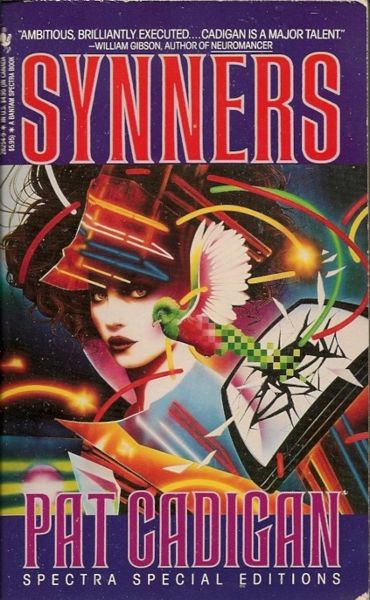That’s What I Want
Synners
By Pat Cadigan

25 Oct, 2022
Pat Cadigan’s 1991 Synners is a stand-alone cyberpunk novel.
The world after the Big One is a wired world, where services of all kinds, especially porn, are a click away. While there are the usual idealists chasing pointless dreams like art and creativity, the corporations run the world. To exist is to be forced to purchase and to feed one’s privacy to the corporate maw.
Having mastered the legal and political systems and thus removed the regulatory guardrails, an ambitious corporation is about to discover it is not immune to consequences.
Implants transformed the medical landscape. The troubled and unproductive can be transformed into useful members of society by the right implant. Alternatively, the self-indulgent can render themselves orthogonal to society’s needs by choosing implants that serve merely personal goals1.
Conventional implants are machines, requiring surgical procedures and risking immune system rejection. Diversifications, Inc., a voracious organization dedicated to relentless expansion, believes it has acquired cutting edge technology that will transform implants as dramatically as implants changed medicine: biological implants facilitating direct mind-machine interfaces without the risks and complications of standard implants.
Diversifications is just as relentless about acquiring staff as it is about accumulating new IP. Thus, the cast of thousands who populate the novel, drawn into Diversifications’ vortex. Enticed by a steady wage or blackmailed into service, they serve their corporate overlords.
Diversifications is adept at many things, not least of which is strong-arming the government into permitting the development of a new technology with alarming implications. However, as civilization discovers to its enormous cost, Diversifications has a blind spot: it won’t acknowledge that its tech has some nasty failure modes. If those modes were publicized, this would threaten the corporation’s short-term income stream. Lips are zipped.
Refusal to publicize the problem doesn’t prevent the problem from happening. Networked people start dropping dead. Entire cities go silent. Diversifications has put the networked world in peril. Now it is up to the usual rag-tag bunch of people to save the world.
~oOo~
Among the alarming implications of implant technology: society takes a broad view of what constitutes a characteristic demanding implant correction. Autism is mentioned in passing. One has to wonder what other non-conformist tendencies are helpfully fixed by the medical technicians of tomorrow. Perhaps it would be more convenient for society if everyone were right-handed …
So, about the names of the protagonists: this has a cast of thousands and I cannot possibly cram them into my synopsis. What I can say is that Cadigan avoids using the usual cyberpunk protagonists (Byronic gangsters and cybernetically enhanced femme fatales) and features adults who have to deal with issues like marriage, divorce, mortgages, and alienated kids. The criminal class in this novel isn’t at all romantic, just squalid and seedy.
The novel makes a strong case for rigorously enforced strong industrial health and safety regulations. The visionaries at Diversifications should have been regulated and inspected. As should have the Pinto automobile, the Space Shuttle, and leaded gas. Diversification’s new tech turns out to be bad for society in general and (in the end) tremendously inconvenient for Diversifications. The fallout is especially hard on the executives who die while discovering first-hand the drawbacks of their new technology.
Near-future SF often enters an uncanny valley when the books reach Synners’ age. The setting is clearly not the future we got, without being so off the mark that it is charmingly retro. Synners manages to avoid this uncanny valley. The setting is clearly not our present, but it’s not an unreasonable present for us to have reached from 19912. A lot of Synner’s world is analogous to ours (something like Waze pops up early on), just implemented differently because the technology developed down different lines.
One detail that has aged very well: having experienced a potentially civilization-ending mishap that could easily have been avoided with a modicum of caution, society’s collective response is to shrug its shoulders and memory-hole the calamity before resuming business as usual.
Something I found amusing when I did some research is that reviews consistently agree that the book is slow to start, but that if one persists past a certain fraction of the book, it pays off. What they don’t agree on is how far one has to press on before pay off. Is it 25%? Half? 75%? Mileage varies! Having reread the book after thirty years, I can assert with complete assurance it is one of those3. But the important thing is that there is a there there, that persistence will be rewarded with something more than “what the hell?”
Synners is available here (Amazon US), here (Amazon Canada), here (Amazon UK), here (Barnes & Noble), here (Book Depository), and here (Chapters-Indigo).
1: E.g., the fellow whose implants make him drop (temporarily) dead from time to time, which makes him less unhappy. However, this is incredibly inconvenient for his friends.
2: An exception: VR requires full body suits and room to move, because virtual and real-world movement map onto each other one to one. It’s closer to motion capture than conventional VR. If this had been how we tackled VR, it would be even stupider than the Metaverse.
3: It takes about a quarter of the book to introduce everyone and about half for everything to crystalize into a unified narrative. The big crisis kicks off at about the three quarters mark.
